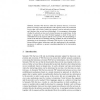Free Online Productivity Tools
i2Speak
i2Symbol
i2OCR
iTex2Img
iWeb2Print
iWeb2Shot
i2Type
iPdf2Split
iPdf2Merge
i2Bopomofo
i2Arabic
i2Style
i2Image
i2PDF
iLatex2Rtf
Sci2ools
95
Voted
SEMWEB
2004
Springer
2004
Springer
Trust Negotiation for Semantic Web Services
Semantic Web Services enable the dynamic discovery of services based on a formal, explicit specification of the requester needs. The actual Web Services that will be used to satisfy the requester’s goal are selected at run-time and, therefore, they are not known beforehand. As a consequence, determining whether the selected services can be trusted becomes an essential issue. In this paper, we propose the use of the Peertrust language to decide if trust can be established between the requester and the service provider. We add modelling elements to the Web Service Modeling Ontology (WSMO) in order to include trust information in the description of Semantic Web Services. In this scenario, we discuss different registry architectures and their implications for the matchmaking process. In addition, we present a matching algorithm for the trust policies introduced.
Related Content
| Added | 02 Jul 2010 |
| Updated | 02 Jul 2010 |
| Type | Conference |
| Year | 2004 |
| Where | SEMWEB |
| Authors | Daniel Olmedilla, Rubén Lara, Axel Polleres, Holger Lausen |
Comments (0)

